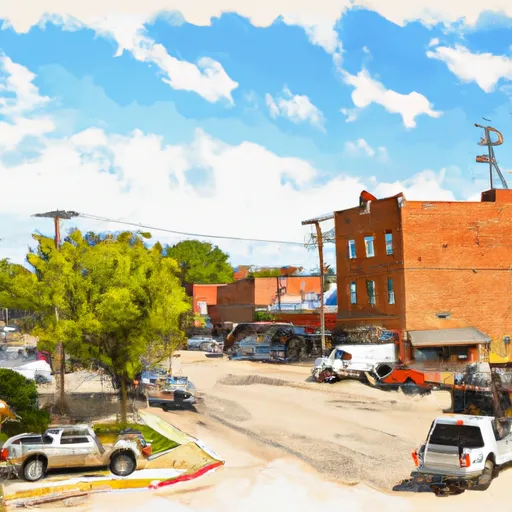-
 Snoflo Premium
Snoflo Premium
Get unlimited access to all our content
With no Ad interruptions! - Start Your Free Trial Login with existing account
Mayfield
Eden Index
Climate
8.3
•
Recreation
0.6
•
Community
•
Safeguard
3.5/10

Mayfield, Kansas is a charming town located in the central region of the state. With a population of approximately 500 residents, Mayfield offers a serene and peaceful environment for residents and visitors alike. The town experiences a continental climate, characterized by hot summers and cold winters. Summers are typically warm and humid, with temperatures averaging around 85°F (29°C), while winters can be quite chilly, with temperatures dropping to around 30°F (-1°C).
Mayfield benefits from its proximity to the Arkansas River, which provides a crucial source of water for the town. The river also offers recreational opportunities such as fishing and boating. Anglers can expect to catch a variety of fish species, including bass, catfish, and crappie. Additionally, the surrounding area is dotted with picturesque lakes and reservoirs, providing further opportunities for water-based activities.
Outdoor enthusiasts will find plenty of opportunities to explore the natural beauty of Mayfield. The town is surrounded by rolling hills and prairies, making it ideal for hiking, birdwatching, and nature photography. Local parks and trails offer opportunities for walking, jogging, and picnicking. Overall, Mayfield offers a peaceful and scenic environment for those seeking to connect with nature or enjoy outdoor recreational activities.
What is the Eden Index?
The Snoflo Eden Index serves as a comprehensive rating system for regions, evaluating their desirability through a holistic assessment of climate health, outdoor recreation opportunities, and natural disaster risk, acknowledging the profound impact of these factors on livability and well-being.
Climate Health Indicator (CHI): 8.3
Mayfield receives approximately
826mm of rain per year,
with humidity levels near 83%
and air temperatures averaging around
14°C.
Mayfield has a plant hardyness factor of
6, meaning
plants and agriculture in this region thrive during a short period during spring and early summer. Most
plants will die off during the colder winter months.
By considering the ideal temperature range, reliable water supplies, clean air, and stable seasonal rain or snowpacks, the Climate Health Indicator (CHI) underscores the significance of a healthy climate as the foundation for quality living.
A healthy climate is paramount for ensuring a high quality of life and livability in a region, fostering both physical well-being and environmental harmony. This can be characterized by ideal temperatures, reliable access to water supplies, clean air, and consistent seasonal rain or snowpacks.
Weather Forecast
Streamflow Conditions
Arkansas - Keystone
Area Rivers
Arkansas - Keystone
Snowpack Depths
Arkansas - Keystone
Reservoir Storage Capacity
Arkansas - Keystone
Groundwater Levels
Recreational Opportunity Index (ROI): 0.6
The Recreational Opportunity Index (ROI) recognizes the value of outdoor recreational options, such as parks, hiking trails, camping sites, and fishing spots, while acknowledging that climate plays a pivotal role in ensuring the comfort and consistency of these experiences.
Access to outdoor recreational opportunities, encompassing activities such as parks, hiking, camping, and fishing, is crucial for overall well-being, and the climate plays a pivotal role in enabling and enhancing these experiences, ensuring that individuals can engage in nature-based activities comfortably and consistently.
Camping Areas
| Campground | Campsites | Reservations | Toilets | Showers | Elevation |
|---|---|---|---|---|---|
| Argonia River Park | 14 | 1,223 ft | |||
| Arcadia Lake | 140 | 1,062 ft | |||
| Guthrie Lake | None | 993 ft | |||
| Wellington Lake East Rec Area | None | 1,225 ft | |||
| Lake Afton Park | None | 1,381 ft | |||
| Wellington Lake West Rec Area | None | 1,216 ft | |||
| Liberty Lake | None | 1,025 ft |
Nearby Ski Areas
Catastrophe Safeguard Index (CSI):
The Catastrophe Safeguard Index (CSI) recognizes that natural disaster risk, encompassing floods, fires, hurricanes, and tornadoes, can drastically affect safety and the overall appeal of an area.
The level of natural disaster risk in a region significantly affects safety and the overall livability, with climate change amplifying these risks by potentially increasing the frequency and intensity of events like floods, fires, hurricanes, and tornadoes, thereby posing substantial challenges to community resilience and well-being.
Community Resilience Indicator (CRI):
The Community Resilience Indicator (CRI) recognizes that education, healthcare, and socioeconomics are crucial to the well-being of a region. The CRI acknowledges the profound impact of these elements on residents' overall quality of life. By evaluating educational resources, healthcare accessibility, and economic inclusivity, the index captures the essential aspects that contribute to a thriving community, fostering resident satisfaction, equity, and social cohesion.

